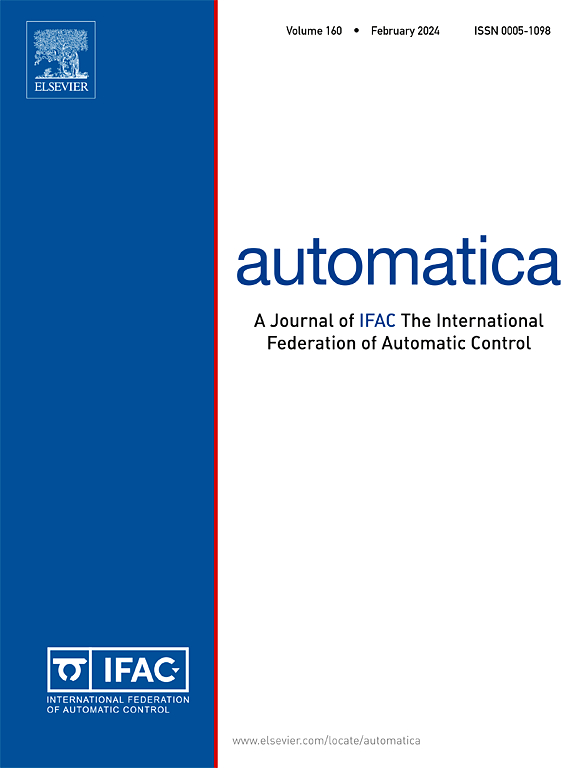Stability of extremum seeking for maps that are strictly but not strongly convex
IF 5.9
2区 计算机科学
Q1 AUTOMATION & CONTROL SYSTEMS
引用次数: 0
Abstract
For a map that is strictly but not strongly convex, model-based gradient extremum seeking has an eigenvalue of zero at the extremum, i.e., it fails at exponential convergence. Interestingly, perturbation-based model-free extremum seeking has a negative Jacobian, in the average, meaning that its (practical) convergence is exponential, even though the map’s Hessian is zero at the extremum. Although these observations for gradient-based extremum seeking control (GESC) are not trivial, in this paper we focus on an even more nontrivial study of the same phenomenon for Newton-based extremum seeking control (NESC). NESC is a second-order method which corrects for the unknown Hessian of the unknown map, not only in order to speed up parameter convergence, but also (1) to make the convergence rate user-assignable in spite of the unknown Hessian, and (2) to equalize the convergence rates in different directions for multivariable maps. Previous NESC work established stability only for maps whose Hessians are strictly positive definite everywhere, so the Hessian is invertible everywhere. For a scalar map, we establish the rather unexpected property that, even when the map is strictly convex but not strongly convex, i.e., when the Hessian may be zero, NESC guarantees practical asymptotic stability, semiglobally. While a model-based Newton-based algorithm would run into non-invertibility of the Hessian, the perturbation-based NESC, surprisingly, avoids this challenge by leveraging the fact that the average of the perturbation-based Hessian estimate is always positive, even though the actual Hessian may be zero. However, these stability results for the NESC, and even for the GESC, do not hold for multivariable maps. We show that these ESCs can be locally destabilized for certain symmetric maps by highly asymmetric dither choices. Thus, we present unexpected robustness of NESC on maps that are scalar and strictly but not necessarily strongly convex.
严格但非强凸映射极值搜索的稳定性
对于严格凸但不强凸的映射,基于模型的梯度极值搜索在极值处特征值为零,即指数收敛失败。有趣的是,基于微扰的无模型极值搜索在平均情况下有一个负的雅可比矩阵,这意味着它的(实际)收敛是指数的,即使地图的Hessian在极值处为零。虽然这些观察结果对于基于梯度的极值寻求控制(GESC)来说并不平凡,但在本文中,我们将重点研究基于牛顿的极值寻求控制(NESC)的相同现象。NESC是对未知映射的未知Hessian进行校正的二阶方法,不仅可以加快参数收敛速度,而且可以(1)在未知Hessian的情况下使收敛速率用户可分配,(2)在不同方向上均衡多变量映射的收敛速率。以前的NESC工作只建立了那些黑森系数处处都是严格正定的地图的稳定性,因此黑森系数处处都是可逆的。对于标量映射,我们建立了一个意想不到的性质,即当映射是严格凸而不是强凸时,即当Hessian可能为零时,NESC保证了实际的半全局渐近稳定性。虽然基于模型的牛顿算法会遇到黑森的不可逆转性,但令人惊讶的是,基于扰动的NESC通过利用基于扰动的黑森估计的平均值总是正的这一事实,避免了这一挑战,即使实际的黑森可能为零。然而,这些稳定性结果对于NESC,甚至对于GESC,并不适用于多变量图。我们证明了这些ESCs可以通过高度不对称的抖动选择来局部破坏某些对称映射。因此,我们提出了NESC在标量和严格但不一定是强凸的映射上的意外鲁棒性。
本文章由计算机程序翻译,如有差异,请以英文原文为准。
求助全文
约1分钟内获得全文
求助全文
来源期刊

Automatica
工程技术-工程:电子与电气
CiteScore
10.70
自引率
7.80%
发文量
617
审稿时长
5 months
期刊介绍:
Automatica is a leading archival publication in the field of systems and control. The field encompasses today a broad set of areas and topics, and is thriving not only within itself but also in terms of its impact on other fields, such as communications, computers, biology, energy and economics. Since its inception in 1963, Automatica has kept abreast with the evolution of the field over the years, and has emerged as a leading publication driving the trends in the field.
After being founded in 1963, Automatica became a journal of the International Federation of Automatic Control (IFAC) in 1969. It features a characteristic blend of theoretical and applied papers of archival, lasting value, reporting cutting edge research results by authors across the globe. It features articles in distinct categories, including regular, brief and survey papers, technical communiqués, correspondence items, as well as reviews on published books of interest to the readership. It occasionally publishes special issues on emerging new topics or established mature topics of interest to a broad audience.
Automatica solicits original high-quality contributions in all the categories listed above, and in all areas of systems and control interpreted in a broad sense and evolving constantly. They may be submitted directly to a subject editor or to the Editor-in-Chief if not sure about the subject area. Editorial procedures in place assure careful, fair, and prompt handling of all submitted articles. Accepted papers appear in the journal in the shortest time feasible given production time constraints.
 求助内容:
求助内容: 应助结果提醒方式:
应助结果提醒方式:


